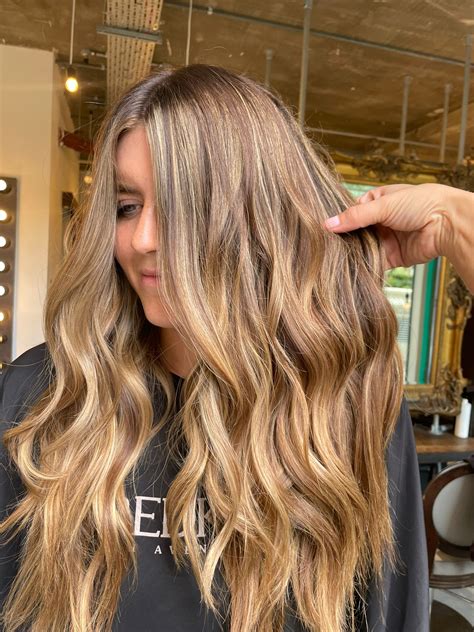Introduction
Balayage and highlights are two popular hair coloring techniques that can add dimension, texture, and brightness to any hair type. While both techniques involve applying lightener to selected strands of hair, they achieve different effects due to their application methods.

What is Balayage?
Balayage (French for “to sweep”) is a freehand hair painting technique where color is applied in thin, irregular strokes from root to tip. This creates a natural, sun-kissed look with a seamless blend of lighter and darker hues. Balayage is ideal for those seeking a low-maintenance, lived-in color that grows out gracefully.
What are Highlights?
Highlights involve applying lightener to small, evenly spaced sections of hair using foil or plastic caps. This creates more defined, contrasting streaks of color that add radiance and brightness to the overall look. Highlights are suitable for all hair types but are particularly flattering on straight or fine hair.
Benefits of Balayage and Highlights
- Enhanced Dimension and Texture: Both techniques add depth and dimension to the hair, creating a flattering play of light and shadow.
- Natural and Lived-In Look: Balayage offers a more subtle, natural-looking color that mimics the effects of sun exposure.
- Versatile: Highlights can be customized to create a variety of looks, from subtle to bold, while balayage is best suited for a more blended, effortless style.
- Low-Maintenance: Balayage requires less frequent touch-ups than traditional highlights, as the regrowth is less noticeable.
- Brightens and Enhances Skin Tone: Both balayage and highlights can brighten the complexion and enhance the appearance of facial features.
Drawbacks of Balayage and Highlights
- Time-Consuming: Both techniques can be time-intensive to apply, especially for longer or thicker hair.
- Can Damage Hair: Lighteners can cause some damage to the hair’s cuticle, especially if overprocessed.
- Can Be Expensive: Professional balayage or highlight services can be costly, depending on the length and thickness of the hair.
- Not Suitable for All Hair Types: Balayage may not be suitable for all hair types, especially very dark or curly hair.
Which Technique is Right for You?
The best choice between balayage and highlights depends on your individual preferences and hair type:
- Balayage is ideal for:
- Those seeking a natural, sun-kissed look
- Those with low-maintenance hair preferences
- Those with medium to coarse hair textures
- Highlights are ideal for:
- Those desiring more defined, contrasting color
- Those with fine or straight hair textures
- Those who prefer a more dramatic color transformation
Types of Balayage and Highlights
Types of Balayage:
- Rooty Balayage: Leaves the roots darker for a more natural grow-out
- Ombré Balayage: Creates a gradual transition from darker roots to lighter tips
- Reverse Balayage: Lightens the roots while leaving the mids and ends darker
- Foilyage: Combines balayage with foiling for a more defined effect
Types of Highlights:
- Full Foil Highlights: Lightens large sections of hair for a bolder look
- Partial Foil Highlights: Lightens smaller sections of hair for a more subtle effect
- Babylights: Creates fine, weaved-in highlights for a dimensional effect
- Chunky Highlights: Contrasting, thick streaks of color for a bold statement
Balayage and Highlights for Different Hair Colors
Balayage and Highlights on Blonde Hair:
– Enhances natural highlights and creates a sun-kissed effect
– Adds warmth and depth to cool-toned blondes
– Can brighten platinum blondes without creating brassiness
Balayage and Highlights on Brunette Hair:
– Creates a rich, dimensional effect
– Adds warmth and radiance to dark brown hair
– Can lighten brown hair without drastic color change
Balayage and Highlights on Red Hair:
– Enhances the natural copper or auburn tones
– Adds depth and definition to vibrant red shades
– Can tone down overly bright reds
Tips for Maintaining Balayage and Highlights
- Use color-protecting shampoo and conditioner
- Avoid heat styling or use heat protectant
- Get regular trims to remove split ends
- Touch up your color as needed to prevent fading
- Consult with a professional stylist for personalized aftercare advice
The Future of Balayage and Highlights
The popularity of balayage and highlights is expected to continue in the coming years, with new advancements and techniques emerging. Some innovative trends to watch out for include:
- Nano-Balayage: Using ultra-fine sections of hair for a more seamless blend
- 3D Balayage: Adding multiple shades of color to create a multidimensional effect
- Color Melting: A hybrid technique that combines the subtle blend of balayage with the precision of highlights
- Digital Balayage: Using technology to precisely apply color in custom patterns
